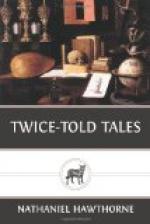This incident reminds me of a young girl—a pale, slender, feeble creature most unlike the other rosy and healthful damsels of the Vineyard, amid whose brightness she was fading away. Day after day did the poor maiden come to the sculptor’s shop and pass from one piece of marble to another, till at last she pencilled her name upon a slender slab which, I think, was of a more spotless white than all the rest. I saw her no more, but soon afterward found Mr. Wigglesworth cutting her virgin-name into the stone which she had chosen.
“She is dead, poor girl!” said he, interrupting the tune which he was whistling, “and she chose a good piece of stuff for her headstone. Now, which of these slabs would you like best to see your own name upon?”
“Why, to tell you the truth, my good Mr. Wigglesworth,” replied I, after a moment’s pause, for the abruptness of the question had somewhat startled me—“to be quite sincere with you, I care little or nothing about a stone for my own grave, and am somewhat inclined to scepticism as to the propriety of erecting monuments at all over the dust that once was human. The weight of these heavy marbles, though unfelt by the dead corpse or the enfranchised soul, presses drearily upon the spirit of the survivor and causes him to connect the idea of death with the dungeon-like imprisonment of the tomb, instead of with the freedom of the skies. Every gravestone that you ever made is the visible symbol of a mistaken system. Our thoughts should soar upward with the butterfly, not linger with the exuviae that confined him. In truth and reason, neither those whom we call the living, and still less the departed, have anything to do with the grave.”
“I never heard anything so heathenish,” said Mr. Wigglesworth, perplexed and displeased at sentiments which controverted all his notions and feelings and implied the utter waste, and worse, of his whole life’s labor. “Would you forget your dead friends the moment they are under the sod?”
“They are not under the sod,” I rejoined; “then why should I mark the spot where there is no treasure hidden? Forget them? No; but, to remember them aright, I would forget what they have cast off. And to gain the truer conception of death I would forget the grave.”
But still the good old sculptor murmured, and stumbled, as it were, over the gravestones amid which he had walked through life. Whether he were right or wrong, I had grown the wiser from our companionship and from my observations of nature and character as displayed by those who came, with their old griefs or their new ones, to get them recorded upon his slabs of marble. And yet with my gain of wisdom I had likewise gained perplexity; for there was a strange doubt in my mind whether the dark shadowing of this life, the sorrows and regrets, have not as much real comfort in them—leaving religious influences out of the question—as what we term life’s joys.




